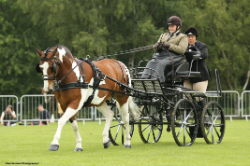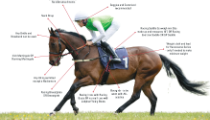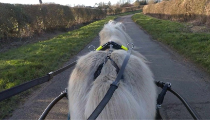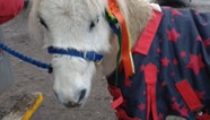Horses have been domesticated for thousands of years. Throughout the centuries, they have been used with chariots for ancient warfare during the Bronze and Iron Ages, with carts for transporting goods, for hauling heavy loads, for ploughing fields, pulling barges along the canals and by the 17th century with carriages for transporting people.
The chariot was a relatively light vehicle, usually on two wheels, drawn by one or more horses, often carrying two standing persons, a driver and a fighter. The chariot was considered the supreme military weapon in Eurasia but it was also used for hunting in Egypt and in sporting contests such as chariot races at the Olympic Games in Greece and at the Roman Circus Maximus in Italy which could seat 250,000 people. Chariot races were extremely popular; cheering crowds were thrilled by the speed and skill of drivers, who were competing on four-horse chariots, quadrigae, and two-horse chariots, bigae.
The Roman chariots were made from wood and leather; they were light, fast and easy to manoeuvre. Over the centuries, the chariot as we know it evolved from the ancient two-wheel vehicle to a four-wheel carriage for transporting people.
Early carriages were little more than boxes on four wheels. Coupled with poor roads, they made the journey extremely uncomfortable. Over the years the quality of both roads and carriages improved so much that it became very popular amongst the wealthy who owned their own private coaches.
With the rise of motorised transport and the arrival of the railways, horse-drawn transport started to decline. By the early 1950s very few people were using horse-drawn carriages as a mean of transportation. However, a few connoisseurs and enthusiasts in several countries decided to form carriage driving societies such as The British Driving Society (BDS) formed in 1957. The aim of these societies was to promote carriage driving, support their members and encourage them to practice carriage driving for pleasure. They offered training, competitions and social events. Today carriage driving is still going strong and thriving in leisure, business and competitive arenas.
Pleasure driving is a great way to enjoy the beautiful British countryside. There are many charity and pleasure drives throughout the year; a relaxing way to enjoy private estates and stunning scenery.
It is also a recognised sport where horses and ponies are hitched to a two or four-wheeled show cart. The horses are shown at a walk and two trotting speeds, with an emphasis on manners. In addition the horses are judged on performance, quality and conformation. Different horse breeds are used in the sport of pleasure driving, as any breed of horse can be trained for pleasure driving. The carts used are usually light and two-wheeled, though four-wheeled fine harness carts are sometimes used at the highest levels of competition.
Horse-drawn carriages are also used as hearses; their history goes back to the 17th century when they first appeared to replace biers carried by mourners. In the 19th century a specific style of hearse emerged: mahogany carriages with black velvet drapes. During the Victorian era, glass-sided hearses were popular, because by-passers were often keen to see the coffin drawn by horses through the streets.
The black horses, whose job was to pull hearses, were known as the Black Brigade. They were Flemish horses imported from Holland and Belgium. Highly trained to stand still, quiet and reliable on crowded city roads.
The nostalgic appeal of a horse-drawn carriage is still very popular today; considered an elegant and regal option for both funerals and weddings. With one or two pairs of black or white horses, horse-drawn funerals and wedding precossions are eco-friendly, visually spectacular and add distinction and elegance.
Carriage Driving has evolved over the years and today is one of the most popular equestrian sports and pleasure activities in the United Kingdom and across Europe. Whether you are an expert driver or completely new to it, Zilco can help you choose the right harness. Through a network of knowledgeable and reliable stockists, Zilco provide sales and support.





